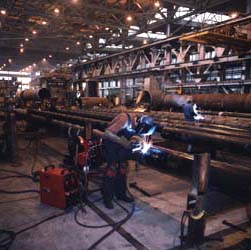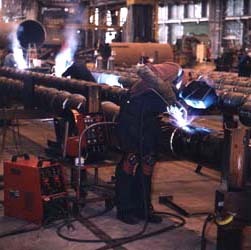NEW EQUIPMENT SPEEDS UP THE WELDING OF PIPE PILINGS FOR BRIDGE BUILDING AND REINFORCING

Visit the San Francisco Bay area and you will note the large number of bridges that shuttle traffic in and out of the city everyday. Located on nearby Mare Island in Vallejo, California is XKT Engineering Inc. The company’s location on the bay and access to barge transportation, make it the perfect firm to handle bridge reinforcement and new construction projects. These projects require the use of pipe pilings that run anywhere from 60 to 160 feet in length. To handle this AWS code-quality work quickly and efficiently, XKT has turned to the Surface Tension Transfer® (STT®) process from The Lincoln Electric Company. This process is able to put in the pipe’s root weld pass three to four times faster than the former process of stick welding. And STT welding is easier to perform for XKT’s 23 certified welders.
"Prior to the STT, we were using a stick process or back-up bars," says Corkey Bates, Welding Engineer/Production Manager for XKT Engineering, Inc. "When welding a 24" diameter pipe, we would use approximately 10 to 12 consumable rods, which means a lot of starting and stopping. With the STT, we weld ¼ of the pipe at a time, so we only start and stop four times while laying the root pass. This means increased speed in welding for the root pass. And, because the STT root pass cross-section (or nugget) is larger than in the past, the hot (or second pass) goes much faster as well. Also, with fewer starts and stops, we have decreased the potential for welding imperfections like porosity and cratering."
XKT uses Lincoln’s STT on pipe that is 30” diameter or less with a wall thickness of up to 1 1/8”. To date, the three STT machines purchased by XKT have been used to weld the pipe pilings for such projects as the San Mateo Hayward Bridge and the suspension span across the Cartinez Straits. According to Bob Ford, XKT Engineering marketing manager, the 13-year old company has carved out a niche business for itself. “We are known for large, complex projects that can require tons of pipe or heavy structural weldments. Not only do we excel and provide advantages to our customers fabricating difficult projects; but also, because of our location, we can provide finished product in large segments by barge, reducing some of the transportation costs or field erection costs."
In addition to pipe pilings for bridges, XKT also produces such things as offshore rigs and fixtures, barges, mobile transport trucks, trusses for structures, heavy complex weldments and structural retrofit steel. XKT’s handiwork can be seen in the trusses at the new San Francisco Airport and in the mobile transport trucks at Cape Kennedy.
“If it’s built out of steel, we feel comfortable tackling it,” says Ford. “We have our own engineering group and can bid on almost anything. We are a certified AISC, Cbd, Cbr with fracture critical endorsements and ASME Section VIII, Div. 1 pressure vessel shop.”
So how exactly did XKT Engineering choose the STT over other welding products on the market for welding its pipe piling? According to Bates, the company was looking for a more efficient way to put in the root and hot pass when it noticed the product highlighted in a case study. To test out the product for himself, he contacted the local Lincoln office, which brought an STT machine to XKT’s shop for a demonstration.
“Our welds must pass either radiographic or ultrasonic inspection to AWS D1.1 standards for cyclically loaded tension stress welds. With the STT, we were easily achieving these quality welds on our root pass,” notes Bates. “We also noticed that the STT generated less spatter and fume than our previous stick process, which meant less clean-up and the ability to go right to submerged arc for the fill and cap passes.”
The STT power source uses high frequency inverter technology with Lincoln’s Waveform Control Technology™ to produce a weld with reduced spatter and smoke. It does this by sensing and adjusting the weld current during the welding process to optimize the finished bead.

“With STT we experience faster fitting and rooting,” explains Bates. “Since all the settings are programmed into the machine, it takes the variables out of welding which means the operators just pull the trigger and weld.”
XKT uses the STT on carbon steels A106 Grade B, 252 Grade 3 and A709 Grade 50 with wall thicknesses that range from ½” to 1 1/8” and diameters from 4” to 72”. The STT provides complete penetration of the root pass. Wire used for the process is Lincoln Electric L-56™ .045” with 100 percent CO2 shielding gas.
The Piling Press
Primarily what XKT does is to take 40-foot pipe lengths or 10 to 12 ft long rolled and welded cylinders and weld them together to produce finished pipe pilings to a specified length. These pilings are being used extensively in California for seismic retrofitting of bridges.
The first step of the process is to determine how to weld the pipe. Pipe under 30” in diameter is welded with the STT for the root pass while larger diameter pipe bypasses this step and goes straight to submerged arc.
The pipe is then rolled on turning rolls to the submerged arc station to complete the fill and cap welds. For submerged arc, XKT has also turned to Lincoln power sources such as the AC 1200, DC 1000 and DC 1500 and accompanying NA-3 and NA-4 wire feeders. Consumables at XKT are 100 percent Lincoln and in the case of submerged arc station, it requires an L-61 wire in either a 5/32” or 5/64” diameter and 860 flux. “Basically, we use submerged arc for anything that we can fixture,” claims Bates.
The third station at XKT is where ultrasonic non-destructive testing is completed. According to Bates, the amount of testing done on any one job can be between 25 to 100 percent depending on what is specified in the customer contract. Once complete, the pipe is transported out, usually by barge to all areas of the U.S. and even overseas.
For all welding other than pipe, XKT turns to FCAW. This includes the welding on all structural shape items such as bridge girders and bulkhead gates. Lincoln products used for this welding include DC 600 power sources with LN-7 and LN-9 wire feeders. Lincoln Outershield® 71M wire is used for flux-cored welding in diameters that range from 1/16” to .045”.
Other Welding at XKT

“I’ve had a lot of success with Lincoln. The support and service we receive is outstanding,” notes Bates. “Any questions we’ve had have been able to be answered locally by our Lincoln representative, John Goetz, or we can easily get them answered by a quick call to Cleveland. According to Bates, Lincoln representatives were on-site to train operators in using the STT, which made a difference.
“Technical support is the number one reason we use Lincoln products and will continue to in the future.”
As more bridgework is coming up for bid in the San Francisco Bay area in the near future, XKT hopes to keep busy and fill the niche for large steel projects.
